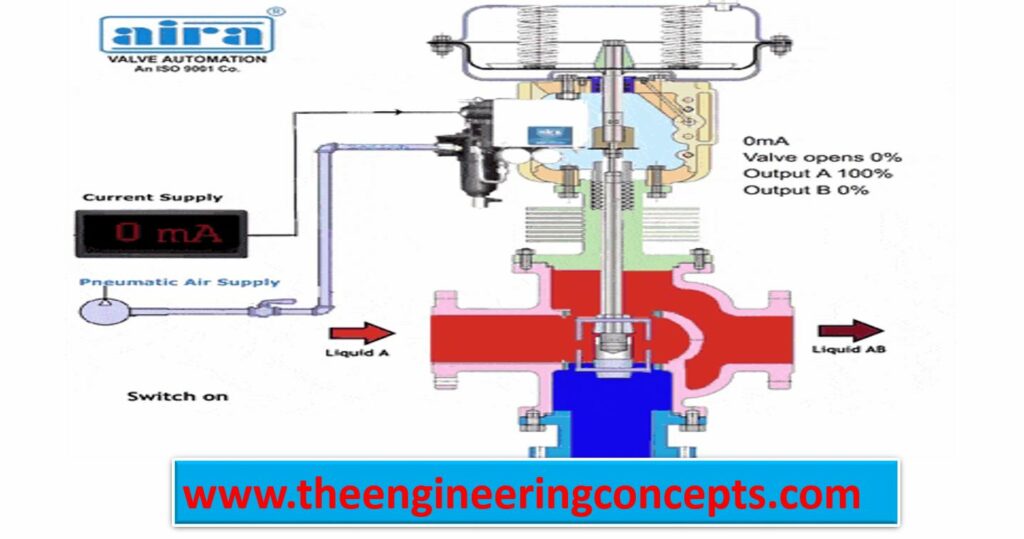Control valves are valves used to control conditions such as flow, pressure, temperature, and liquid level by fully or partially opening or closing in response to signals received from controllers that compare a “setpoint” to a “process variable” whose value is provided by sensors that monitor changes in such conditions.
Control Valve is also termed as the Final Control Element.
Working Animation of Control Valve
The opening or closing of control valves is usually done automatically by electrical, hydraulic or pneumatic actuators. Positioners are used to control the opening or closing of the actuator based on electric, or pneumatic signals.
These control signals, traditionally based on 3-15psi (0.2-1.0bar), more common now are 4-20mA signals for industry.
Read Also
Valve Symbols for P&IDs
Valve (Know Complete Detail About All Valves)
Why Control Valves used?
Process plants consist of hundreds, or even thousands, of control loops all networked together to produce a product to be offered for sale.
Each of these control loops is designed to keep some important process variable such as pressure, flow, level, temperature, etc. within a required operating range to ensure the quality of the end product.
Each of these loops receives and internally creates disturbances that detrimentally affect the process variable, and interaction from other loops in the network provides disturbances that influence the process variable.
To reduce the effect of these load disturbances, sensors and transmitters collect information about the process variable and its relationship to some desired set point. A controller then processes this information and decides what must be done to get the process variable back to where it should be after a load disturbance occurs.
When all the measuring, comparing, and calculating are done, some type of final control element must implement the strategy selected by the controller.
Principles of Operation
The most common final control element in the process control industries is the control valve. The control valve manipulates a flowing fluid, such as gas, steam, water, or chemical compounds, to compensate for the load disturbance and keep the regulated process variable as close as possible to the desired set point.
Control valves may be the most important, but sometimes the most neglected, part of a control loop. The reason is usually the instrument engineer’s unfamiliarity with the many facets, terminologies, and areas of engineering disciplines such as fluid mechanics, metallurgy, noise control, and piping and vessel design that can be involved depending on the severity of service conditions.
Any control loop usually consists of a sensor of the process condition, a transmitter and a controller that compares the “process variable” received from the transmitter with the “set point,” i.e., the desired process condition. The controller, in turn, sends a corrective signal to the “final control element,” the last part of the loop and the “muscle” of the process control system.
While the sensors of the process variables are the eyes, the controller the brain, then the final control element is the hands of the control loop. This makes it the most important, alas sometimes the least understood, part of an automatic control system. This comes about, in part, due to our strong attachment to electronic systems and computers causing some neglect in the proper understanding and proper use of the all important hardware.
A control valve consists of three main parts in which each part exist in several types and designs:
- Valve’s actuator
- Valve’s positioner
- Valve’s body
Types of control valve bodies
The most common and versatile types of control valves are sliding-stem globe and angle valves. Their popularity derives from rugged construction and the many options available that make them suitable for a variety of process applications, including severe service.
Control valve bodies may be categorized as below
- Angle Valves
- Cage-style valve bodies
- DiskStack style valve bodies
- Angle seat piston valves
- Globe valves
- Single-port valve bodies
- Balanced-plug cage-style valve bodies
- High capacity, cage-guided valve bodies
- Port-guided single-port valve bodies
- Double-ported valve bodies
- Three-way valve bodies
- Diaphragm Valves
- Rotary valves
- Butterfly valve bodies
- V-notch ball control valve bodies
- Eccentric-disk control valve bodies
- Eccentric-plug control valve bodies
- Sliding cylinder valves
- Directional control valve
- Spool valve
- Piston valve
- Air-operated valves
- Air-operated valve
- Relay valve
- Air-operated pinch valve
Article Source : Oilfieldwiki; Wikipedia

